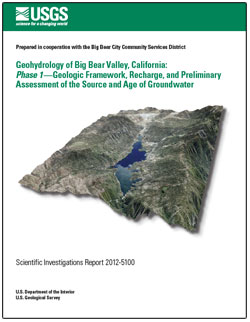 Abstract
Abstract
The Big Bear Valley, located in the San Bernardino Mountains of southern California, has increased in population in recent years. Most of the water supply for the area is pumped from the alluvial deposits that form the Big Bear Valley groundwater basin. This study was conducted to better understand the thickness and structure of the groundwater basin in order to estimate the quantity and distribution of natural recharge to Big Bear Valley.
A gravity survey was used to estimate the thickness of the alluvial deposits that form the Big Bear Valley groundwater basin. This determined that the alluvial deposits reach a maximum thickness of 1,500 to 2,000 feet beneath the center of Big Bear Lake and the area between Big Bear and Baldwin Lakes, and decrease to less than 500 feet thick beneath the eastern end of Big Bear Lake. Interferometric Synthetic Aperture Radar (InSAR) was used to measure pumping-induced land subsidence and to locate structures, such as faults, that could affect groundwater movement. The measurements indicated small amounts of land deformation (uplift and subsidence) in the area between Big Bear Lake and Baldwin Lake, the area near the city of Big Bear Lake, and the area near Sugarloaf, California. Both the gravity and InSAR measurements indicated the possible presence of subsurface faults in subbasins between Big Bear and Baldwin Lakes, but additional data are required for confirmation.
The distribution and quantity of groundwater recharge in the area were evaluated by using a regional water-balance model (Basin Characterization Model, or BCM) and a daily rainfall-runoff model (INFILv3). The BCM calculated spatially distributed potential recharge in the study area of approximately 12,700 acre-feet per year (acre-ft/yr) of potential in-place recharge and 30,800 acre-ft/yr of potential runoff. Using the assumption that only 10 percent of the runoff becomes recharge, this approach indicated there is approximately 15,800 acre-ft/yr of total recharge in Big Bear Valley.
The INFILv3 model was modified for this study to include a perched zone beneath the root zone to better simulate lateral seepage and recharge in the shallow subsurface in mountainous terrain. The climate input used in the INFILv3 model was developed by using daily climate data from 84 National Climatic Data Center stations and published Parameter Regression on Independent Slopes Model (PRISM) average monthly precipitation maps to match the drier average monthly precipitation measured in the Baldwin Lake drainage basin. This model resulted in a good representation of localized rain-shadow effects and calibrated well to measured lake volumes at Big Bear and Baldwin Lakes. The simulated average annual recharge was about 5,480 acre-ft/yr in the Big Bear study area, with about 2,800 acre-ft/yr in the Big Bear Lake surface-water drainage basin and about 2,680 acre-ft/yr in the Baldwin Lake surface-water drainage basin.
One spring and eight wells were sampled and analyzed for chemical and isotopic data in 2005 and 2006 to determine if isotopic techniques could be used to assess the sources and ages of groundwater in the Big Bear Valley. This approach showed that the predominant source of recharge to the Big Bear Valley is winter precipitation falling on the surrounding mountains. The tritium and uncorrected carbon-14 ages of samples collected from wells for this study indicated that the groundwater basin contains water of different ages, ranging from modern to about 17,200-years old.
The results of these investigations provide an understanding of the lateral and vertical extent of the groundwater basin, the spatial distribution of groundwater recharge, the processes responsible for the recharge, and the source and
age of groundwater in the groundwater basin. Although the studies do not provide an understanding of the detailed water-bearing properties necessary to determine the groundwater availability of the basin, they do provide a framework for the future development of a groundwater model that would help to improve the understanding of the potential hydrologic effects of water-management alternatives in Big Bear Valley.